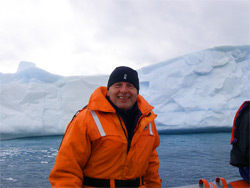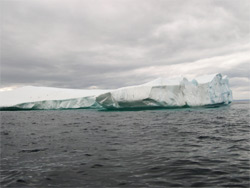Diving 10,000 Year Old Ice
There is a very old dive site that has just been floating around waiting to be discovered…

Every year it is estimated that as many as 50,000 icebergs calve off the glaciers of Greenland to start their long journey south driven by ocean currents. A few hundred travel down the North Atlantic coast of America and make it as far as the island province of Newfoundland. The most famous got in the way of the Titanic 100 years ago (April 1912); and the stream of berg’s since that historic collision has grown stronger in recent years thanks to global climate change.
The process of carving goes on year-round but the best time to see Newfoundland (or Atlantic) icebergs “in person” is in the summer, and one of the best places to find ones that are “safe” to dive is Conception Bay, near that Canadian province’s capital city of St. John’s.
“Safe” of course is an entirely relative term in all types of diving but most certainly in this particular flavor of adventure-diving. An iceberg is a dynamic entity; constantly moving, shifting, stressing and straining. Rolling and splitting are two of the constant threats presented by a huge chunk of frozen fresh water floating in a slightly warmer flow of salt water – and gradually melting away. Of course, these events can be disastrous for anyone close by, whether on the surface or underwater. Because of this and other factors, diveable bergs are bergs that are grounded. These are sometimes called Ice Islands.

You might say that the berg is constantly changing its buoyancy and trim! Only when that hidden portion of the berg bottoms out on the ocean floor is there ANY opportunity to partially manage these risks.
However, few icebergs are held fast for long. As their bulk and mass gradually lessens, buoyancy changes and ever-present currents and tides will tend to push it along, often dragging its way through the seabed. Many berg divers check out this Ice Scour or Gouging – given depth limits – before getting close to the body of the berg. This is an indication of how long the berg has been grounded, and in some part, how it has behaved during its time as an ice island. Also, since the seabed in Newfoundland is home to all manners of cold-water creatures, the gouge often uncovers hidden critters and can attract larger predators to an open feast — take a camera!
Once a berg is confirmed to be grounded, divers usually submerge at a safe distance and swim toward the iceberg. This is one of the most unique experiences. Remember, an iceberg is fresh-water, perhaps more than 10,000 years old. It is pure and unsullied by mankind. As a diver closes in on its walls – which incidentally have the appearance of a multi-hued abstract sculpture – she will pass through the meltwater zone, where seawater and freshwater mix. Her buoyancy will change and she will experience passing through a distinct halocline. Also, the quality of sunlight or daylight will change, and it is not unusual for the visibility around a berg to be “virtually limitless.” The ice itself seems to glow from transmitted sunlight and the berg’s walls will shimmer with countless shades of blue from pale aqua to deep violet.
It will be, all in all, an unforgettable experience.
| Size Category | Height | Length |
| Growler | Less than 1 metre (3.3 ft) | Less than 5 metres (16 ft) |
| Bergy Bit | 1–5 metres (3.3–16 ft) | 5–15 metres (16–49 ft) |
| Small | 5–15 metres (16–49 ft) | 15–60 metres (49–200 ft) |
| Medium | 15–45 metres (49–148 ft) | 60–120 metres (200–390 ft) |
| Large | 45–75 metres (148–246 ft) | 120–200 metres (390–660 ft) |
| Very Large | Over 75 metres (246 ft) | Over 200 metres (660 ft) |
Data supplied by International Ice Patrol
SOMETHING TO THINK ABOUT
Often an iceberg will be surrounded by small chunks of calved ice (Growlers or smaller). If possible, collect one or two of these and use them in your cold drinks (in Newfoundland, this might be an after dive drink of Screech). When berg ice melts, it makes a fizzing sound called “Bergie Seltzer.” This sound is caused by escaping air originally trapped and then compressed as prehistoric snow layers became glacial ice.
WHO IS ICEBERG DIVING FOR?
Iceberg diving is great for advanced divers, equipped and experienced in cold-water diving since even in summer, the water temperatures at depth in Newfoundland hover only a few degrees above freezing. Divers with a sense of adventure and a yen for something out of the ordinary are also recommended.
There are several SDI/TDI instructors working in Newfoundland; to find out more about adventure diving, contact them through our website https://www.tdisdi.com or call us 207.729.4201
REMEMBER no dives outside your comfort and training should be undertaken without proper instruction and guaidance!



Plaats een Reactie
Meepraten?Draag gerust bij!